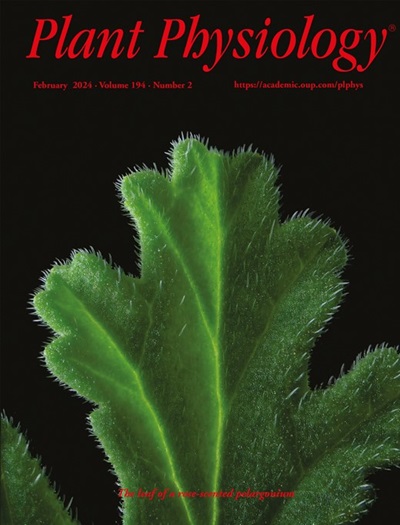m6A解读子SlYTH1通过影响番茄果实中mRNA的稳定性和翻译来调控风味相关挥发物的生物合成
IF 6.5
1区 生物学
Q1 PLANT SCIENCES
引用次数: 0
摘要
n6 -甲基腺苷(m6A)是真核生物中最常见的RNA表观遗传修饰,由甲基转移酶(写入器)催化,由去甲基酶(擦除器)去除,并由结合蛋白(读取器)识别。虽然以前的研究已经确定了m6A稳态在调节果实成熟中的重要作用,但m6A介导的品质性状形成的转录后机制仍然知之甚少。继我们最近发现YT521B同源(YTH)结构域含有m6A解读基因SlYTH2作为番茄(Solanum lycopersicum)香气挥发物产生的翻译抑制因子之后,我们在这里通过敲除SlYTH1揭示了一种独特的调节作用,该调节作用特异性地减少了番茄果实中与香味相关的挥发物,而不影响开花到果实破色、乙烯产生或紧致度的时间。值得注意的是,这一发现与SlYTH2负向调节水果香气的作用形成了对比,突出了SlYTH1和SlYTH2在调节水果香气方面的相反作用。从机制上讲,在体内和体外,SlYTH1都与m6a修饰的mRNA靶标结合,在维持mRNA稳定性和促进翻译方面发挥双重作用。具体来说,SlYTH1功能的丧失加速了两个关键靶点SlBCAT1和SlTNH1的转录物和蛋白质水平的下降,这两个靶点对挥发性生物合成至关重要。本研究揭示了m6A在成熟过程中对果实风味品质的调控作用。此外,它还确定了SlYTH1作为在不改变成熟时间的情况下改善水果风味的潜在遗传靶点。本文章由计算机程序翻译,如有差异,请以英文原文为准。
The m6A reader SlYTH1 regulates flavor-related volatiles biosynthesis via affecting mRNA stability and translation in tomato fruit
N 6-methyladenosine (m6A) is the most prevalent RNA epigenetic modification in eukaryotes, catalyzed by methyltransferases (writers), removed by demethylases (erasers), and recognized by binding proteins (readers). While previous studies have established the essential role of m6A homeostasis in regulating fruit ripening, the post-transcriptional mechanisms underlying m6A-mediated quality trait formation remain poorly understood. Following our recent discovery of a YT521B homology (YTH) domain-containing m6A reader gene, SlYTH2, as a translational repressor for the production of tomato (Solanum lycopersicum) aroma volatiles, we reveal here a distinct regulatory effect through knockout of SlYTH1, which specifically reduces flavor-related volatiles in tomato fruit without affecting the days from anthesis to fruit color break, ethylene production, or firmness. Notably, this finding contrasts with the role of SlYTH2, which negatively regulates fruit aroma, highlighting the opposing effects of SlYTH1 and SlYTH2 in modulating fruit aroma. Mechanistically, SlYTH1 binds to m6A-modified mRNA targets both in vitro and in vivo, performing dual roles in maintaining mRNA stability and promoting translation. Specifically, the loss of SlYTH1 function accelerated the decline in the transcript and protein levels of two key targets, SlBCAT1 and SlTNH1, which are essential for volatile biosynthesis. This study provides insights into the role of m6A modification in regulating fruit flavor quality during ripening. Furthermore, it identifies SlYTH1 as a potential genetic target for improving fruit flavor without altering the timing of ripening.
求助全文
通过发布文献求助,成功后即可免费获取论文全文。
去求助
来源期刊

Plant Physiology
生物-植物科学
CiteScore
12.20
自引率
5.40%
发文量
535
审稿时长
2.3 months
期刊介绍:
Plant Physiology® is a distinguished and highly respected journal with a rich history dating back to its establishment in 1926. It stands as a leading international publication in the field of plant biology, covering a comprehensive range of topics from the molecular and structural aspects of plant life to systems biology and ecophysiology. Recognized as the most highly cited journal in plant sciences, Plant Physiology® is a testament to its commitment to excellence and the dissemination of groundbreaking research.
As the official publication of the American Society of Plant Biologists, Plant Physiology® upholds rigorous peer-review standards, ensuring that the scientific community receives the highest quality research. The journal releases 12 issues annually, providing a steady stream of new findings and insights to its readership.
 求助内容:
求助内容: 应助结果提醒方式:
应助结果提醒方式:


